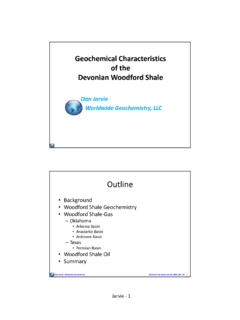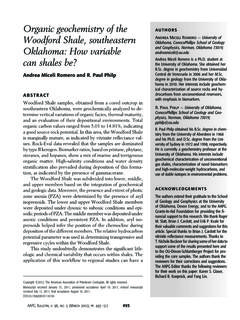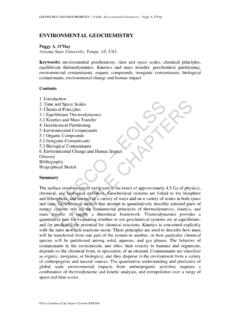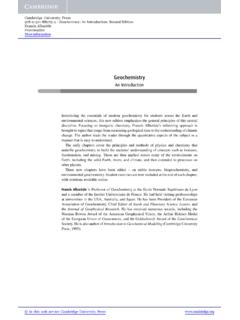Transcription of Geochemistry of Geothermal Fluids Rico, Colorado
1 1 Final ReportGeochemistry of Geothermal FluidsRico, ColoradoMegan SmithTerry BisiarTeuku PutraVan Blackwood2 Table of Primary Geothermal Fluids - This section was adapted from (Arnosson, Steffansson,Bjarnasson,2007) Chemical composition of primary Na-Cl Acid-sulfate High salinity Secondary Steam-heated acid sulfate Carbon-dioxide Mixed ISOTOPE AND fluid INCLUSION STUDIES IN rico , Study Oxygen isotopes Hydrogen isotopes Origin of the hydrothermal Stable isotope composition of the quartz molybdenite Stable isotope composition of the epithermal Physical and geological description of Major element Trace element Geothermometry Na-K Na-K-Ca Silica geothermometers and Mixing Lithium-based Gas Geothermometers Applied at rico , Dunton Hot Geyser Warm Paradise rico core-drill Magnesium Correction to Na-K-Ca derived Conclusions from CGS geothermometer INTRODUCTIONThe purpose of this paper is to describe the importance of Geochemistry with respect to geothermalreservoir characterization.
2 We will briefly describe how Geochemistry is used for reservoir characterizationand in more detail discuss geothermometer and isotope data for the Geothermal reservoir at rico speaking, geochemical fingerprinting is a rapidly expanding discipline in the earth and environmental sciences. It is anchored in the recognition that geological processes leave behind chemicaland isotopic patterns in the rock record. Many of these patterns, informally referred to as geochemicalfingerprints, differ only in fine detail from each other. For this reason, the approach of fingerprinting requires analytical data of very high precision and fingerprinting occurred alongside progress in geochemical analysis techniques. The advancement of in situ analytical techniques is also identified as a major factor that has enabled geochemical fingerprinting to expand into a larger variety of fields (Kamber, 2009). Geothermal Geochemistry research is used to identify the origin of Geothermal Fluids and to quantify theprocesses that govern their compositions and the associated chemical and mineralogical transformations ofthe rocks with which the Fluids interact.
3 The variation in the chemistry of Geothermal Fluids provideinformation regarding the origins, mixing and flow regimes of the systems. The subject has a strong appliedcomponent: Geothermal chemistry constitutes an important tool for the exploration of Geothermal resourcesand in assessing the production characteristics of drilled Geothermal reservoirs and their response toproduction. Geothermal Fluids are also of interest as analogues to ore-forming Fluids . Understandingchemical processes within active Geothermal systems has been advanced by thermodynamic and kineticexperiments and numerical modeling of fluid flow. Deep drillings for Geothermal energy have providedimportant information on sources and composition of Geothermal Fluids , their reaction with rock-formingminerals, migration of the Fluids , and fluid phase separation and fluid mixing processes (Arnosson,Steffansson, Bjarnasson, 2007).According to DiPippo, the geochemist has several responsibilities with respect to Geothermal reservoircharacterization.
4 Namely, identifying whether the resource is vapor- or liquid dominated, estimating theminimum temperature of the geofluid, determine the chemical properties of the fluid both in reservoir andin the produced state, and characterize the recharge water, including its nature and resources. Geothermalfluids are broken down into primary and secondary Primary Geothermal Fluids - This section was adapted from (Arnosson, Steffansson, Bjarnasson,2007)Primary Geothermal Fluids are Fluids located at the bottom of a convection may be a mixture oftwo or more fluid components such as meteoric and seawater and magmatic volatiles. The main types ofprimary Fluids are Na-Cl waters, acid-sulfate waters and high salinity brines. When primary Fluids risetowards the surface, they can undergo fluid phase separation and fluid mixing to form secondarygeothermal Fluids . The most important processes that lead to the formation of secondary Geothermal fluidsare:1) Depressurization boiling to yield boiled water and a steam phase with ) Phase separation of saline Fluids into a hypersaline brine and a more dilute ) Vapor condensation in shallow ground water or surface water to produce acid-sulfate,carbon-dioxide or sodium bicarbonate ) Mixing of CO2 gas from a deep source with thermal ground ) Mixing of Geothermal Fluids with shallower and cooler ground Chemical composition of primary fluidsThe chemical composition of primary Geothermal Fluids is determined by the composition of the source fluidsand reactions involving both dissolution of primary rock-forming minerals and deposition of secondary minerals,as well as by adsorption and desorption processes.
5 The source fl uids are usually meteoric water or seawater or a4mixture thereof. Components of connate, magmatic and metamorphic Fluids may also be present in Na-Cl dissolved salt in Na-Cl waters is mainly NaCl. This type of water is the most common in geothermalsystems. Chloride concentrations typically range from only a few hundred to a few thousand ppm. They arelowest in waters hosted in basaltic rocks but highest in Fluids which have interacted with sedimentary rockscontaining evaporites. The salinity of Geothermal Fluids is determined by the availability of solublesalts. These salts may be leached from the aquifer rock or added to the Geothermal fluid by deepmagmatic Fluids . Alternatively, saline Fluids may form through reactions between magmatic HCl and rock-forming concentrations of most major elements in Na-Cl waters are fixed by close approachto local equilibrium with secondary minerals if temperatures are above ~100 to 150 C. The only conservativemajor component in these waters is Cl.
6 The mineral-solution equilibria constrain ion activity ratios and theactivities of neutral aqueous species other than Cl-bearing species, including reactivegases like CO2, H2S and H2,which may be largely of magmatic origin. Some systems closelyapproach redox equilibrium while others significantly depart from concentrations of many trace elements ( , Ag, Fe, Cu, Pb, Zn) in Na-Cl geothermalwaters are clearly controlled by sulfide mineral deposition. These elements typically form cations in elements that form large simple anions or oxy-anions in solution may have high mobility and even showincompatible behavior (Br, I, As, Mo, W). Acid-sulfate acid-sulfate Fluids have been encountered in many volcanic Geothermal systems, particularly in associationwith andesitic volcanoes. Acidity is caused by HCl or HSO4or both, and evidence indicates that it mostly formsby transfer of HCl and SO2from the magmatic heat source to the circulating measured at 25 C, the pH of flashed acid-sulfate water collected at the wellheadmay be as low as 2.
7 The pH of the water is near neutral at the high temperature in the aquifer,however. Production of acidity upon cooling is related to the increased acid strength of HSO4with decreasingtemperature. The most important difference between the Na-Cl and acid-sulfate waters is that the main pH-buffer of the former is CO2/HCO3, but HSO4/SO4in the latter. Compared to Na-Cl waters, acid SO4-Cl waterscontain higher concentrations of SO4and some minor elements, such as Fe and Mg, which are contained inminerals with pH-dependent Cl concentrations (up to 120 ppm by weight) have been measured in superheated vapor. The Cl in thevapor is transported as HCl. A high Cl concentration in the vapor is due to evaporation of brine. The Clconcentration of the vapor affected by the pH of the brine and the temperature of separation of vapor and High salinity watersGeothermal brines can form in several ways. Brine-forming processes include dissolution of evaporites by waterof meteoric origin and reaction between some primary minerals of volcanic rocks and magmatic HCl.
8 Connatehot water brines have been encountered in sedimentary basins (White 1965). Brines may form by fluid phaseseparation through cooling and depressurization of moderately saline Geothermal Fluids in which case they metals (Ag, Au, Cu, Mo, Pb, Sn, W, Zn) form complexes with Cl , HS and OH atmagmatic temperatures that partition into the magmatic fluid during crystallization. As this fluid escapes fromthe melt into the country rock, these metals together with magmatic gases are transported into the geothermalfluid. Mixing of the magmatic and Geothermal Fluids and their subsequent interaction with rock-forming mineralsleads to brine formation, if the magma is rich in HCl. Cooling and transformation ofmagmatic SO2into H2S leads to precipitation of metallic sulfides. Porphyry ore-deposits are considered to formin this Secondary Steam-heated acid sulfate many high-temperature Geothermal fi elds, surface manifestations consist mostly of steam vents (fumaroles),steam-heated surface water and hot intensely altered ground (Fig.)
9 6). Condensation of H2S-bearing steam by heatloss or mixing with surface water and oxidation of the H2S leads to the formation of native sulfur, thiosulfate,various polysulfides and ultimately sulfate. Steam-heated acid-sulfate waters are characterized by low Cl andrelatively high sulfate concentrations. It is not uncommon that the pH is <1. At low pH, these waters oftencontain many metals ( , Al, Fe, Mn, Cr) in high concentrations. The acid water effectively dissolves theprimary minerals of common volcanic rocks leaving a residue rich in amorphous silica, anatase, native sulfur,sulfides, aluminous sulfates and smectite or Carbon-dioxide and non-thermal waters rich in carbonate carbon are widespread on a global scale. They are particularlycommon in areas of volcanic activity, but are also found in seismically active zones devoid of volcanic , CO2-waters occur at the boundaries of volcanic Geothermal systems and around active emissions from active Geothermal systems and active volcanoes are largely diffuse and notconfined to fumarole and hot spring emissions.
10 Some CO2-waters form by mixing of mantle-derived, magmaticor metamorphic CO2with ground or surface waters. In volcanic Geothermal systems, CO2-waters may form bycondensation of CO2-containing vapor in perched aquifers or by mixing of downward percolating CO2-richcondensate with the deep primary Geothermal fluid . Finally, CO2-waters may form by mixing of high-temperature Geothermal fluid that has not undergone fluid phase separation with cool ground ( 2H) and oxygen-18 ( 18O) data indicate that the CO2-waters are meteoric by origin. Tritium analysessuggest, at least in some instances, short residence times. The content of14C is low due to extensive dilution by14C-dead carbon from the deep source. CO2-waters are often considerably mineralized (Table 2) because the CO2makes the water quite reactive by maintaining relatively low pH, thus increasing the rate of dissolution of manycommon primary rock-forming minerals by enhancing their degree of undersaturation. The low pH may alsoreduce adsorption of many trace metal cations onto iron-hydroxide or other minerals and in this way increase themobility of these Mixed up-flow zones of Geothermal systems ascending boiled or unboiled water may mix with shallow ground , the thermal fluid that mixes with the cooler ground water may be two-phase (liquid and vapor).









